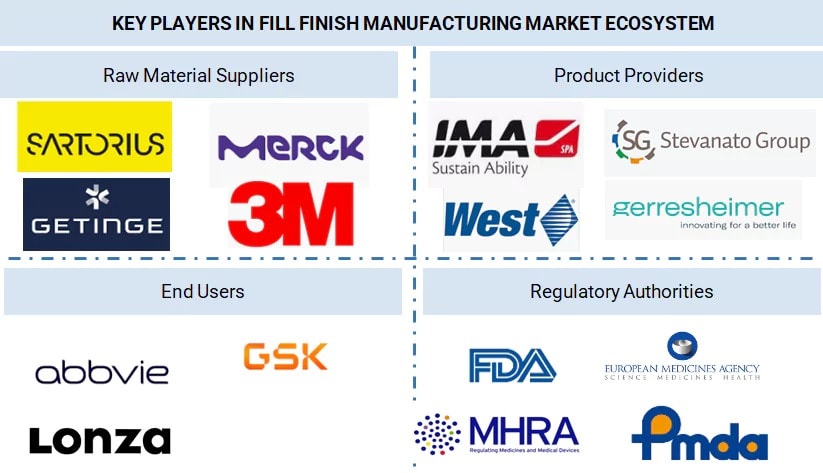The global fill finish manufacturing market, valued at US$16.85 billion in 2024, has increased to US$18.36 billion in 2025 and is projected to grow at a robust CAGR of 8.9% from 2025 to 2030, reaching US$28.14 billion by the end of the forecast period.
This growth trajectory is primarily driven by the increasing demand for automated and small-batch fill finish solutions tailored to the needs of personalized medicine and biologics manufacturing. However, high capital investment (CAPEX) requirements associated with isolators and robotic aseptic lines continue to pose financial challenges, particularly for small and mid-sized manufacturers.
Download PDF Brochure of Fill Finish Manufacturing Market
Market Driver
GLP-1, Biosimilars, and Vaccine Pipeline Expansion Driving Biologics Volumes
The rapid proliferation of GLP-1 receptor agonists, biosimilars, and vaccines is significantly boosting activity in the fill finish manufacturing sector. Rising global prevalence of obesity and diabetes has fueled the adoption of GLP-1 therapies, necessitating expanded sterile fill finish capacity.
Meanwhile, the growing wave of biosimilar approvals—notably across oncology, autoimmune, and metabolic disorders—continues to increase production volumes. Parallelly, sustained investment in vaccine R&D, including mRNA and recombinant platforms, demands scalable and flexible fill finish infrastructure capable of operating under stringent aseptic and cold chain conditions.
In response, contract development and manufacturing organizations (CDMOs) are rapidly expanding capacity and adopting advanced automation to meet biologics production timelines efficiently and compliantly.
Market Restraint
High CAPEX Requirements for Isolators and Robotic Aseptic Lines
While robotic aseptic systems and isolators provide superior sterility assurance and regulatory compliance (including EU Annex 1 standards), their upfront costs—often in the tens of millions—remain prohibitive for smaller manufacturers.
Additional expenses for facility retrofitting, validation, staff training, and maintenance further heighten the financial burden. This has led many companies, especially in emerging markets, to rely on semi-automated systems—slowing the pace of modernization and limiting the adoption of next-generation aseptic processing solutions.
Market Opportunity
Rising Demand for Cell & Gene Therapy and mRNA Small-Batch Manufacturing
The global shift toward cell and gene therapies (CGTs) and mRNA-based treatments presents a lucrative opportunity for fill finish manufacturers. These therapies typically require small-batch, high-value production with exceptional precision and flexibility.
Following the success of mRNA vaccine platforms, the continued expansion of CGT and mRNA pipelines has intensified demand for single-use, closed-system, and modular aseptic filling technologies.
CDMOs equipped with micro-batch filling, advanced automation, and regulatory expertise are positioned to lead this evolving niche, unlocking premium revenue streams in a rapidly advancing segment of biologics manufacturing.
Market Challenge
Transition Toward Sustainable and PFAS-Free Consumables
The industry faces growing regulatory and environmental pressure to eliminate PFAS (per- and polyfluoroalkyl substances) from consumables used in fill finish operations. Regulatory scrutiny across the EU, US, and UK is accelerating the shift toward PFAS-free, sustainable materials in tubings, filters, and single-use components.
However, identifying viable alternatives that maintain chemical resistance, sterility, and biologic compatibility remains complex and costly. Manufacturers must balance environmental mandates with operational reliability, which may temporarily increase costs and extend validation timelines for high-throughput aseptic operations.
Market Segmentation Highlights
By Product:
The consumables segment is expected to hold the largest market share in 2024, driven by its essential role in maintaining sterility and process efficiency.
Consumables such as pre-sterilized vials, stoppers, prefilled syringes, and cartridges are increasingly preferred for their ready-to-use (RTU) convenience, reducing sterilization steps and accelerating time-to-market.
The rise of pre-filled delivery systems continues to reinforce the dominance of consumables within aseptic processing workflows.
By End User:
Contract Manufacturing Organizations (CMOs) are projected to exhibit the highest growth rate through 2030.
Rising outsourcing trends among pharma and biotech firms reflect a strategic focus on R&D, with CMOs providing advanced technologies, cost efficiency, and scalability.
The need for flexibility, regulatory compliance, and rapid product turnaround further strengthens CMOs’ central role in the global fill finish value chain.
Regional Insights
The Asia Pacific region is expected to record the fastest growth rate over the forecast period. Rapid expansion in biopharmaceutical manufacturing, coupled with government incentives and investment in healthcare infrastructure, is transforming countries such as China, India, and South Korea into pivotal manufacturing hubs.
Factors such as low operational costs, rising chronic disease burden, and skilled workforce availability are attracting global outsourcing to the region. Meanwhile, North America and Europe continue to maintain strong market positions, supported by established biologics pipelines, advanced technologies, and stringent regulatory oversight.
Key Market Players
Leading companies in the global fill finish manufacturing market include:
Syntegon Technology GmbH (Germany); I.M.A. S.P.A. (Italy); BD & CO. (US); West Pharmaceutical Services, Inc. (US); Gerresheimer AG (Germany); AptarGroup, Inc. (US); Dätwyler Holding Inc. (Belgium); Danaher (US); Stevanato Group S.p.A. (Italy); OPTIMA (Germany); Bausch+Ströbel (Germany); Groninger & Co. GmbH (Germany); SGD PHARMA (France); SCHOTT (Germany); Nipro Corporation (Japan); Bausch Advanced Technology Group (US); and Maquinaria Industrial Dara, SL (Spain).

